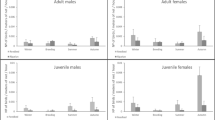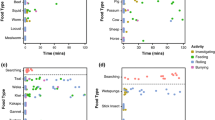Abstract
The carbon isotope composition of an animal’s breath reveals the composition of the nutrients that it catabolizes for energy. Here we describe the use of Keeling plots, a method widely applied in ecosystem ecology, to measure the δ13C of respired CO2 of small vertebrates. We measured the δ13C of Rufous Hummingbirds (Selasphorus rufus) in the laboratory and of Mourning (Zenaida macroura) and White-winged (Z. asiatica) Doves in the field. In the laboratory, when hummingbirds were fed a sucrose based C3 diet, the δ13C of respired CO2 was not significantly different from that of their diet (δ13CC3 diet). The δ13C of respired CO2 for C3 fasted birds was slightly, albeit significantly, depleted in δ13C relative to δ13CC3 diet. Six hours after birds were shifted to a sucrose based C4 diet, the isotopic composition of their breath revealed that birds were catabolizing a mixture of nutrients derived from both the C3 and the C4 diet. In the field, the δ13C of respired CO2 from Mourning and White-winged Doves reflected that of their diets: the CAM saguaro cactus (Carnegeia gigantea) and C3 seeds, respectively. Keeling plots are an easy, effective and inexpensive method to measure δ13C of respired CO2 in the lab and the field.



Similar content being viewed by others
References
Baker HG, Baker I (1983) Floral nectar sugar constituents in relation to pollinator type. In: Jones CE, Little RJ (eds) Handbook of experimental pollination biology. Van Nostrand Reinhold, New York, pp 117–141
Bearhop S, Waldron S, Votier SC, Furness RW (2002) Factors that influence assimilation rates and fractionation of nitrogen and carbon stable isotopes in avian blood and feathers. Physiol Biochem Zool 75:451–458
Ben David M, Hanley TA, Schell DM (1998) Fertilization of terrestrial vegetation by spawning Pacific salmon: the role of flooding and predator activity. Oikos 83:47–55
Dawson TE, Mambelli S, Plamboeck AH, Templer PH, Tu KP (2002) Stable isotopes in plant ecology. Annu Rev Ecol Syst 33:507–559
DeNiro MJ, Epstein S (1977) Mechanism of carbon fractionation associated with lipid synthesis. Science 197:261–263
DeNiro MJ, Epstein S (1978) Influence of diet on the distribution of carbon isotopes in animals. Geochim Cosmochim Acta 42:495–506
Flanagan LB, Ehleringer JR (1997) Ecosystem—atmosphere CO2 exchange: interpreting signals of change using stable isotope ratios. Trends Ecol Evol 13:10–14
France RL (1995) Differentiation between littoral and pelagic food webs in lakes using stable isotopes. Limnol Oceanogr 40:1310–1313
Hatch KA, Pinshow B, Speakman JR (2002a) The analysis of 13C/12C ratios in exhaled CO2: its advantages and potential application to field research to infer diet, changes in diet over time, and substrate metabolism in birds. Integr Comp Biol 42:21–33
Hatch KA, Pinshow B, Speakman JR (2002b) Carbon isotope ratios in exhaled CO2 can be used to determine not just present, but also past diets in birds. J Comp Physiol B 172:263–268
Hobson KA (1995) Reconstructing avian diets using stable-carbon and nitrogen isotope analysis of egg components: patterns of isotopic fractionation and turnover. Condor 97:752–762
Hobson KA (1999) Tracing origins and migrations of wildlife using stable isotopes: a review. Oecologia 120:314–326
Hobson KA, Clark RG (1992a) Assessing avian diets using stable isotopes I: turnover of 13C in tissues. Condor 94:181–188
Hobson KA, Clark RG (1992b) Assessing avian diets using stable isotopes II: factors influencing diet tissue fractionation. Condor 94:189–197
Hobson KA, Sealy SG (1991) Marine protein contributions to the diet of northern sawwhet owls on the Queen Charlotte Islands: a stable-isotope approach. Auk 108:437–440
Keeling CD (1958) The concentration and isotopic abundances of atmospheric carbon dioxide in rural areas. Geochim Cosmochim Acta 24:322–334
Keeling CD (1961) A mechanism for cyclic enrichment of carbon-12 by terrestrial plants. Geochim Cosmochim Acta 24:299–313
Martínez del Rio C, Wolf BO (2003) Mass balance models for animal isotopic ecology: linking diet’s stoichiometry and physiological processes with broad scale ecological patterns. In: Starck JM, Wang T (eds) Physiological and ecological adaptations to feeding in vertebrates. Science Publishers, Berlin
Metges C, Kempe K, Schmidt HL (1990) Dependence of the carbon-isotope contents of breath carbon dioxide, milk, serum and rumen fermentation of products on the d13C value of food in dairy cows. Br J Nutr 63:187–196
Normand S, Pachiaudi C, Khalfallah Y, Guilluy R, Mornex R, Riou JP (1992) 13C appearance in plasma glucose and breath CO2 during feeding with naturally enriched starchy food in normal humans. Am J Clin Nutr 55:430–435
Obrien DM, Schrag DP, Martinez del Rio C (2002) Allocation to reproduction in a hawkmoth: a quantitative analysis using stable carbon isotopes. Ecology 81:2822–2831
Post DM (2002) Using stable isotopes to estimate trophic position: models, methods, and assumptions. Ecology 83:703–718
Schoeller DA, Klein PD, Watkins JB, Heim T, Maclean WC Jr (1980) 13C abundances of nutrients and the effect of variations in 13C isotopic abundances of test meals formulated for 13CO2 breath tests. Am J Clin Nutr 33:2375–2385
Schoeller DA, Brown C, Nakamura K, Nakagawa A, Mazzeo RS, Brooks GA, Budinger TF (1984) Influence of metabolic fuel on the 13C/12C ratio of breath CO2. Biomed Mass Spectrom 11:557–561
Stott AW, Davies E, Evershed RP (1997) Monitoring the routing of dietary and biosynthesized lipids through compound-specific stable isotope (δ13C) measurements at natural abundance. Naturwissenschaften 84:82–86
Tieszen AA, Boutton TW, Tesdahl KG, Slade NA (1983) Fractionation and turnover of stable carbon isotopes in animal tissues: implications for δ13C analysis of diet. Oecologia 57:32–37
Vleck D (1987) Measurement of oxygen consumption, carbon dioxide production, and water vapor production in a closed system. J App Phys 62:2103–2106
Wolf BO, Martinez del Rio C (2000) Use of saguaro fruit by white-winged doves: isotopic evidence of a tight ecological association. Oecologia 124:536–543
Wolf BO, Martinez del Rio C, Babson J (2002) Stable isotopes reveal that saguaro fruit provides different resources to two desert dove species. Ecology 83:1286–1293
Yakir D, Sternberg LDL (2000) The use of stable isotopes to study ecosystem gas exchange. Oecologia 123:297–311
Zar JH (1996) Biostatistical analysis. Prentice Hall, New York
Acknowledgements
Nina Joy and Ela Tsahar helped in the laboratory and Dan Reinking guided us in the use of Colorado State University’s mass spectrometer. Craig Cook, Mike Lott and the SIRFER Lab at the University of Utah allowed us the use of their mass spectrometer. Jim Ehleringer gave us the insight that Keeling plots could be used on animals. The research was supported by NSF IBN-0110416 to C.M.R. and by NSF BIR-9627541 to B.O.W.
Author information
Authors and Affiliations
Corresponding author
Rights and permissions
About this article
Cite this article
Carleton, S.A., Wolf, B.O. & del Rio, C.M. Keeling plots for hummingbirds: a method to estimate carbon isotope ratios of respired CO2 in small vertebrates. Oecologia 141, 1–6 (2004). https://doi.org/10.1007/s00442-004-1643-y
Received:
Accepted:
Published:
Issue Date:
DOI: https://doi.org/10.1007/s00442-004-1643-y




